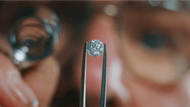Do Lab-Created Diamonds Hold Value
Oct 13th 2023
Investors and consumers often wonder that do lab-created diamonds hold value as compared to their natural counterparts. Lab-created diamonds have become increasingly popular, offering a more ethical and sustainable alternative to mined diamonds. But one of the most common questions about lab-created diamonds is whether or not they hold their value.
Lab-created diamonds are real diamonds that are grown in a laboratory environment. They have the same chemical composition optical, and physical properties as mined diamonds. The only way to tell the difference between a lab-created diamond and a mined diamond is with specialized equipment.
How Are lab-Created Diamonds Made?
Two main methods exist for creating diamonds in a laboratory: the high-pressure high-temperature (HPHT) method and the chemical vapor deposition (CVD) method.
The HPHT method places a small diamond seed in a chamber with carbon and a metal catalyst. The chamber is then heated to high temperatures and subjected to high pressures. This causes the carbon to crystallize around the seed, forming a diamond.
In the CVD method, a carbon-containing gas is introduced into a chamber with a diamond seed. The gas is heated, causing the carbon to break down and deposit on the seed. This process is repeated until the desired size and shape of the diamond is formed.
The Ongoing Debate On Do lab-Created Diamonds Hold Value?
Lab-created diamonds are typically less expensive than mined diamonds but do not hold their value. One of the reasons for this is that the supply of lab-created diamonds is increasing while the demand for mined diamonds remains relatively stable.
Another reason why lab-created diamonds do not hold their value as well as mined diamonds is that they are not as widely accepted by the jewelry industry. Economic factors also determine the answer of question that do lab created diamonds hold value over time in fluctuating market. Many traditional jewelers do not sell lab-created diamonds and those that do typically offer lower prices for them.
However, it is important to note that the resale value of lab-created diamonds is increasing. As the market for lab-created diamonds grows, more jewelers will begin to sell them, and demand for them will increase. This will lead to higher resale prices for lab-created diamonds.
How Much Value Do lab-created Diamonds lose?
The value a lab-created diamond loses will vary depending on many factors, including the diamond's carat weight, color, clarity, and cut. However, when resold, lab-created diamonds can generally lose up to 50% of their value.
Tips for buying lab-created diamonds
If you are considering buying a lab-created diamond, there are a few things you can do to protect your investment:
Buy From A Reputable Dealer
Ensure the dealer is accredited by a reputable organization, such as the Gemological Institute of America (GIA).
Get A Certificate Of Authenticity
This document will attest to the quality and characteristics of the diamond.
Have the diamonds been insured? This will protect you financially in case the diamond is lost or stolen.
In addition to the factors mentioned above, there are a few other things that can affect the resale value of lab-created diamonds:
The Brand: Some brands of lab-created diamonds have a better reputation than others. Lab-created diamonds from a well-known brand are likely to hold their value better than those from a lesser-known brand.
The Market: The resale value of lab-created diamonds will fluctuate depending on the market conditions. If the demand for lab-created diamonds is high, the resale value will be higher. If the demand for lab-created diamonds is low, the resale value will be lower.
The Condition Of The Diamond: The resale value of a lab-created diamond will also be affected by its condition. A lab-created diamond in good condition will likely hold its value better than a lab-created diamond in poor condition.
Lab-grown diamonds are cheaper than real diamonds for some reasons:
Cost of production:
Lab-grown diamonds can be produced for a fraction of the cost of mined diamonds. This is because mining diamonds is very expensive, involving heavy machinery and a large workforce. Lab-grown diamonds, on the other hand, can be produced in a controlled laboratory environment with relatively low overhead costs.
Supply and demand:
The supply of lab-grown diamonds is increasing, while the demand for mined diamonds remains relatively stable. This is because lab-grown diamonds are a newer technology, and more and more companies are starting to produce them. As the supply of lab-grown diamonds increases, the price will continue to decrease.
Perception:
Lab-grown diamonds are not as widely accepted by the jewelry industry as mined diamonds.Traditionalist may question that do lab created diamonds hold value without the geological rarity associated with natural diamonds .This is because many believe lab-grown diamonds are less valuable than mined diamonds. However, as more and more people become aware of the benefits of lab-grown diamonds, their perception is changing. The above aspects explain why lab-grown diamonds are cheaper than real diamonds
The diamond dilemma: Lab-created Diamonds Hold Value
Despite being cheaper than mined diamonds, lab-grown diamonds are real diamonds with the same chemical composition, optical properties, and physical properties as mined diamonds. The only way to tell the difference between a lab-grown diamond and a mined diamond is with specialized equipment.
As the market for lab-grown diamonds continues to grow, they are expected to become even more affordable. This is good news for consumers seeking a more ethical and sustainable alternative to mined diamonds.
Conclusion
As consumer preference evolves, the question that do lab created diamonds hold value becomes a pivotal aspect of the diamond industry’s future. While lab-created diamonds do not hold their value as well as mined diamonds, they are still a valuable investment. Lab-created diamonds are real diamonds with the same beauty and durability as mined diamonds. However, it is important to be aware of the factors that can affect the resale value of lab-created diamonds before you make a purchase.

